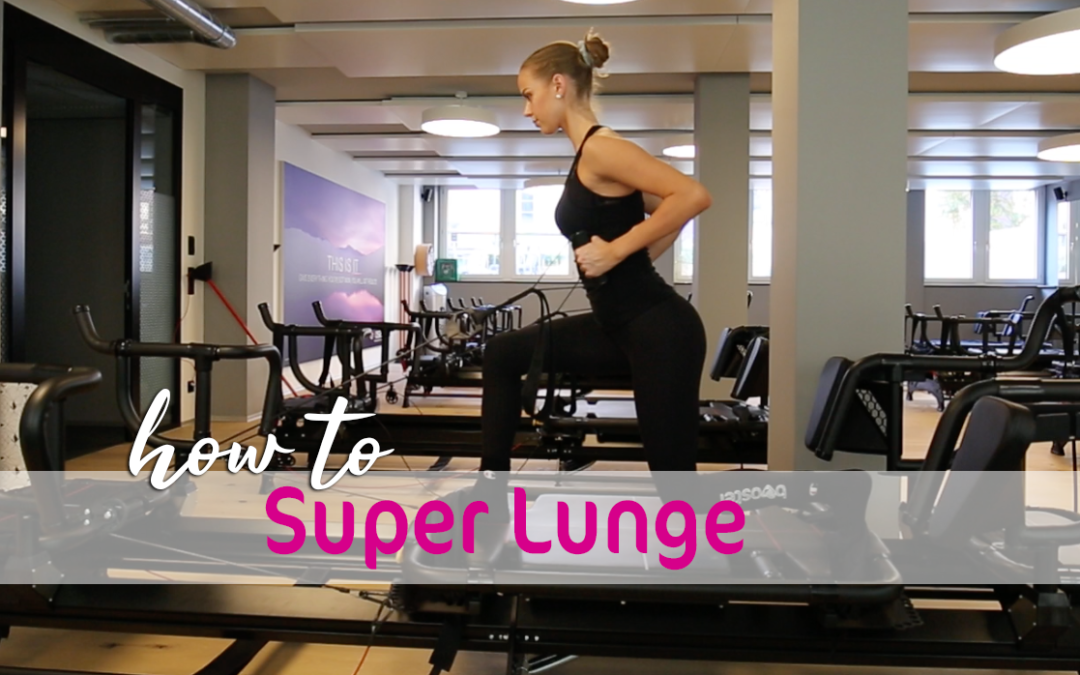Megamove of the month of November 2018: Super Lunge
‘How to Super Lunge’!
In November, we will be focusing on perfecting your Super Lunge, an exercise performed to strengthen your hamstrings, glutes, quads and arms! Until the end of November, all classes will include a Super Lunge, or one of its variations. Our instructors will focus on providing detailed explanations on how to perform the exercise in perfect form.
To offer you even more key pointers, our Instagram and Facebook pages will continue to relay pictures and videos of our coaches (and maybe a few clients) doing the move!
The perfect Super Lunge
The Super Lunge, is one of the signature Lagree Fitness Method lower body exercises that not only gets your quadriceps working, but also works your glutes, hamstrings, arms, back, and abdominals. A true full-body exercise if you ask us!
The Super Lunge is performed using 1 red and 2 yellow springs, on the Megaformer’s carriage facing the back of the room, holding on to the black handles. One foot is placed around the eleven line (marked on the carriage), while the other one is placed around number one line. The movement is done by slowly with control, pulling the carriage out by standing up on the carriage, using the back of the front leg (your target/working leg), and pulling on the handles. On the way down, you focus on resisting the carriage on its way back in, stopping just before your back knee touches the carriage, while extending your arms out. The back-leg acts as what we call a secondary mover. It is very important to keep your front knee stationary throughout the exercise, and not locking the knee as you extend your front leg. It is also important to keep your abs engaged to support the lower back and help to balance your body on the carriage. This exercise targets all the muscles in the legs and the trunk.
The most common modification for the Super Lunge, is to remain kneeling on the carriage and only work your arms. We recommend staying on the carriage if you are new to super lunge, or do not yet feel 100% comfortable with the move. On the other hand, a variation of the Super Lunge would be to add in isometric holds hovering over the carriage, and just moving the arms, or adding in pulses. Your arms can also work differently while performing the Super Lunge. You can do the move with the classic “row”, but also with a bicep curl, or chest opener. You can also perform the exercise on 2red and 1yellow springs to the move, in order to shift the focus to your arms.
Adrienne’s Super Lunge
Notice how in her video, Adrienne starts the Super Lunge performed on one red and two yellow springs, with the classic arm row combination. To spice up the move, she later switches to a bicep curl and adds in challenging isometric holds with her legs. With proper alignment, you will notice that her front knee never surpasses her toes. To fully engage the hamstrings, glutes and quads of her front leg, she presses her front foot into the carriage and straightens both legs, while drawing the back handles toward her body on the way to standing. While dropping back down towards the carriage, she bends both knees while her arms almost fully straighten. The slower she moves, the more controlled, effective, and challenging the exercise becomes.
If at any point throughout the move, you start to feel unstable, you can always take a quick break by bringing your back knee all the way down onto the carriage, and only moving your arms, keeping your core engaged.
Common Mistakes
Arm coordination
Although there are a variety of upper body arm movements that can be incorporated into the Super Lunge, the arm movement should counter-balance the lunge, and help to balance your body. In other words, on the way up to standing, tension in the cables should increase, and not decrease. This means that most likely, you should be bending somewhere at the elbows as you rise, and extending your arms out as you lower down. This helps to make sure your arms are helping you balance. Many times, we see clients doing the opposite, i.e. straightening their arms as they straighten their legs which makes them a lot less stable.
Hip alignment
Due to the challenge and lack of stability with this move, clients might try to help themselves by sinking into their focus hip. This means that the hip connected to their back leg drops lower than that of their front leg. Not only does this misalign your spine, but also makes the exercise less effective, not letting work all the muscles you’re supposed to be working. To help you keep both hips aligned, focus on engaging your core, and especially your oblique on the side of your back leg. Engaging the oblique’s will help either hip to begin to sink. Like most leg exercises, you also want to think about having your hips and shoulders squared off.
Cable length
As previously mentioned, you want to make sure there is tension in your cables at all times. If you are on the taller side, or simply feel as though you might need more tension in your cables to help you stabilize yourself, you might want to grab on to the metal rings where your cables and footstraps connect. You will notice that the Megaformers at our Studio Selnau actually have finger placements on the metal piece. If you are a little taller, or would like to reduce the tension in your arms, you can also switch from holding onto the handles, to the footstraps.


































